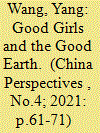| Srl | Item |
| 1 |
ID:
182944


|
|
|
|
|
| Summary/Abstract |
During the most robust years of his career, 1949 to 1964, the artist Shi Lu 石魯 (1919-1982) frequently painted young rural women. The appearance of peasant women in the art of the early Maoist period ostensibly demonstrates the suitability of the subject for visualising state policies that promoted social transformation and women’s liberation. While participating in these nation-building efforts, Shi Lu’s images of peasant women were also a product of global art historical influences, namely allegorical depictions, that manifested subtle influence on the development of twentieth-century Chinese art. The identity of the artist, a Yan’an cadre who provided creative and administrative support to the official art system, reveals how artists navigated political expectations as state functionaries while simultaneously defining them through artistic exploration. Through the case study of Shi Lu and the hybridised global artistic traditions that gave rise to the subject of young peasant women in Maoist China, this article reveals the porousness of an era that has been considered isolated from global currents outside of the Soviet sphere.
|
|
|
|
|
|
|
|
|
|
|
|
|
|
|
|
| 2 |
ID:
192282


|
|
|
|
|
| Summary/Abstract |
In Turkey, land reform was subject to fierce debates among different political groups throughout the 1960s. Land occupations and small peasant demonstrations were seen as new forms of struggle to voice demands for land reform. This article explores the gender and class specific effects of global post-war American expansion policies on agrarian change and peasant struggle in the form of land occupations in rural Turkey. Focusing on the Aegean villages of Golluce and Atalan in the late 1960s, it argues that different political organizations imagined villages as laboratories to test their visions of land reform and the occupiers as a homogeneous class regardless of gender-specific claims. In doing so, it highlights the characteristics of rural class struggles and the politics of land reform with reference to social class and gender in Turkey in this period.
|
|
|
|
|
|
|
|
|
|
|
|
|
|
|
|